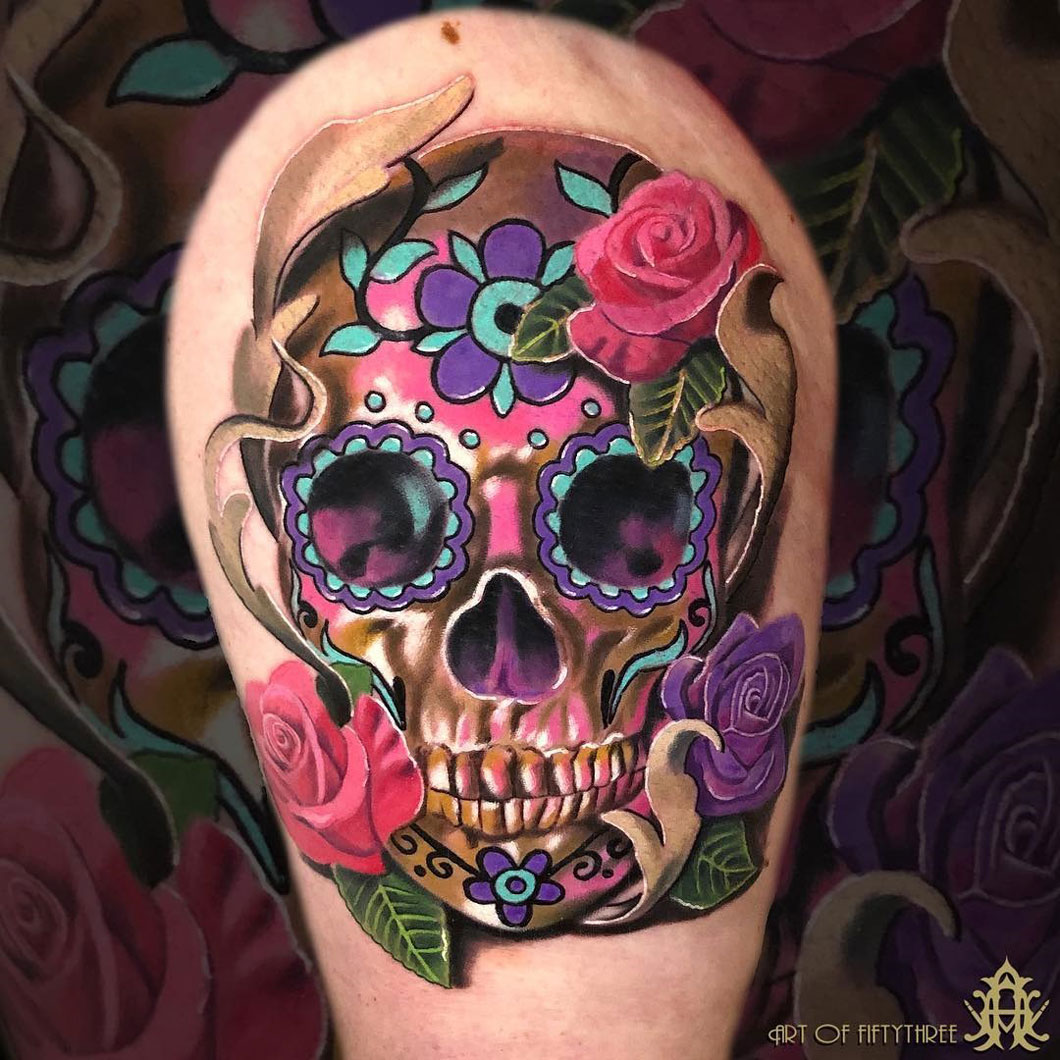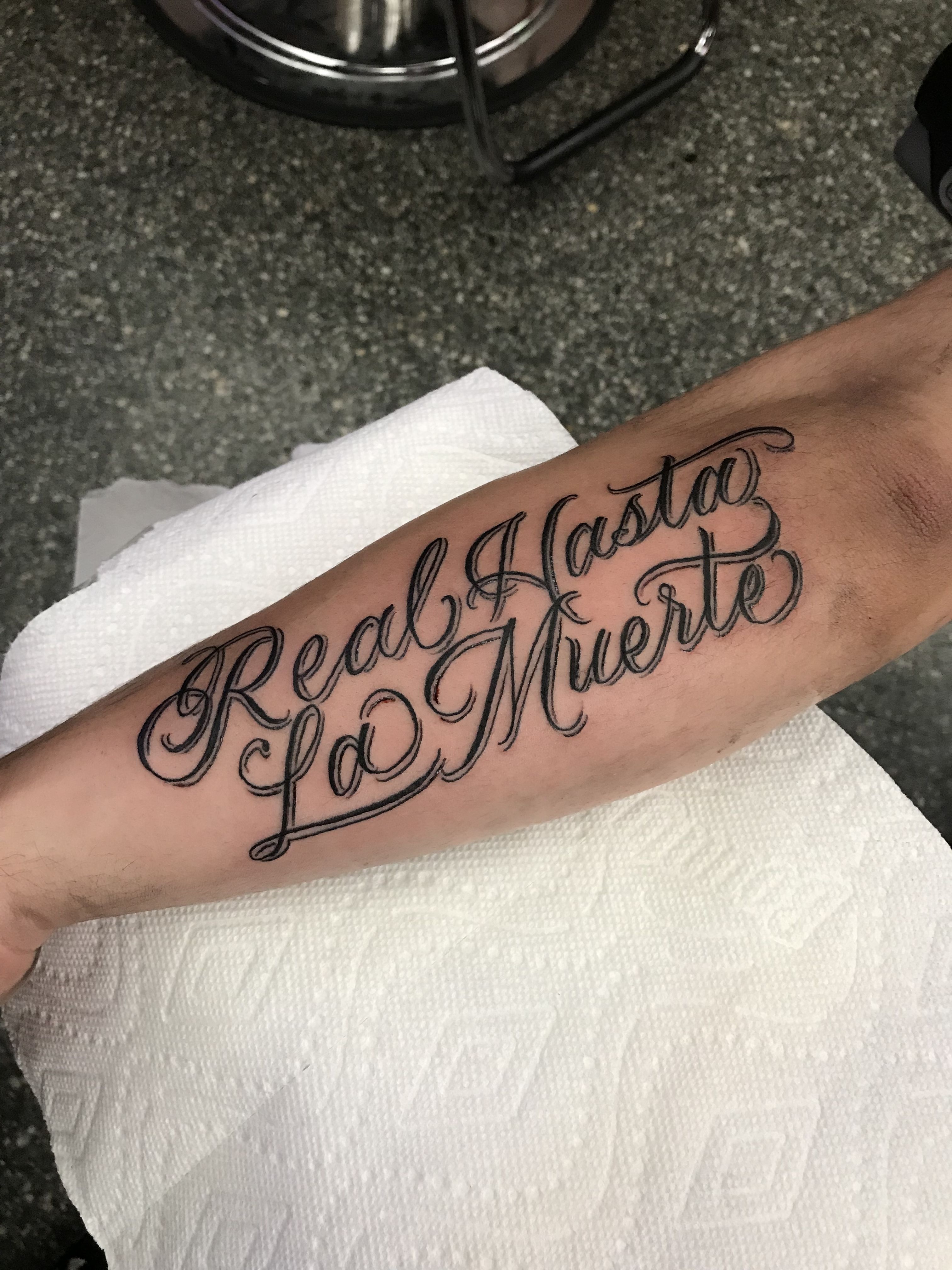Tattoos have long been a form of artistic expression, allowing individuals to adorn their bodies with meaningful and visually stunning creations. Among the myriad of tattoo styles, the Catrina tattoo stands out as a unique and captivating choice, particularly within the realm of Mexican folk art. Rooted in the rich cultural heritage of Mexico, these tattoos pay homage to the iconic Calavera Catrina, a skeletal figure popularized by the renowned Mexican artist José Guadalupe Posada. In this comprehensive exploration, we delve into the world of Catrina tattoos, uncovering their origins, their evolving artistic interpretations, and their enduring popularity among tattoo enthusiasts worldwide.
The Historical Roots of Catrina Tattoos

To truly appreciate the significance of Catrina tattoos, one must journey back to the early 20th century, a period marked by political and social transformations in Mexico. It was during this time that José Guadalupe Posada, a talented printmaker and political satirist, created his iconic Calavera Catrina illustration. Posada’s work, often characterized by its sharp social commentary, depicted a high-society woman with a skeletal face, donning an elegant hat. This image served as a powerful critique of the Mexican elite, who, despite the country’s economic struggles, continued to emulate European fashion trends.
However, beyond its satirical origins, Calavera Catrina also held deeper cultural and spiritual meanings. It became a symbol of Dia de los Muertos, or Day of the Dead, a Mexican holiday celebrated on November 1st and 2nd. During this festive occasion, families honor their departed loved ones, transforming cemeteries into vibrant spaces adorned with marigolds, candles, and offerings. The Calavera Catrina, with her elegant yet skeletal appearance, embodies the spirit of this celebration, reminding us of the beauty and acceptance of death as an inherent part of life.
Catrina Tattoos: An Artistic Evolution

In the realm of tattoos, the Calavera Catrina has undergone a remarkable artistic evolution, transcending its original political context to become a versatile and highly personalized symbol. Tattoo artists worldwide have embraced the Catrina figure, infusing it with their unique styles and creative interpretations. From intricate black-and-gray sketches to vibrant color palettes, each tattoo tells a unique story, reflecting the individual’s connection to Mexican culture, their personal experiences, or their artistic preferences.
The versatility of Catrina tattoos extends beyond artistic styles. These tattoos can be designed to fit various body parts, ranging from delicate wrists and ankles to bold back pieces. Some individuals opt for realistic depictions, showcasing the intricate details of the skeletal face and elegant attire, while others prefer more stylized interpretations, incorporating elements of nature, animals, or other cultural symbols.
Furthermore, the symbolism behind Catrina tattoos is open to interpretation. For some, it represents a celebration of life and a reminder to embrace the beauty of mortality. For others, it serves as a tribute to their Mexican heritage, a way to connect with their cultural roots, and honor their ancestors. The Catrina figure, with its enigmatic smile, becomes a powerful talisman, offering protection and guidance on life's journey.
Exploring the Artistic Interpretations
The world of Catrina tattoos is a vast canvas, offering endless possibilities for creative expression. Here, we delve into some of the most captivating artistic interpretations that have emerged in recent years.
Traditional Mexican Folk Art
Some tattoo artists draw inspiration from the rich traditions of Mexican folk art, incorporating vibrant colors, intricate patterns, and cultural symbols into their Catrina tattoos. These tattoos often feature bold outlines, reminiscent of the traditional papel picado (perforated paper) decorations seen during Dia de los Muertos celebrations. The use of bright hues, such as marigold yellow, fiery red, and vibrant purple, adds a festive touch, evoking the joyful spirit of the holiday.
| Artistic Style | Traditional Mexican Folk Art |
|---|---|
| Color Palette | Vibrant, including marigold yellow, red, and purple |
| Elements | Intricate patterns, papel picado-inspired designs |
| Symbolism | Celebration of life, connection to Mexican heritage |

Neo-Traditional Tattoos
Neo-traditional tattoos draw on the classic American traditional style but with a modern twist. In the context of Catrina tattoos, this style often features bold outlines, vibrant colors, and a slightly cartoonish aesthetic. These tattoos capture the playful spirit of the Catrina figure, bringing a touch of whimsy to the skeletal image.
| Artistic Style | Neo-Traditional |
|---|---|
| Outline | Bold, black outlines |
| Color | Vibrant, often with a pop of color |
| Aesthetic | Slightly cartoonish, playful |
Realistic Black-and-Gray Tattoos
For those seeking a more subtle yet powerful statement, realistic black-and-gray Catrina tattoos offer an elegant option. These tattoos showcase the artist’s mastery of shading and contouring, bringing a three-dimensional quality to the skeletal figure. The absence of color allows the focus to remain on the intricate details of the face and attire, creating a hauntingly beautiful effect.
| Artistic Style | Realistic Black-and-Gray |
|---|---|
| Shading | Intricate, realistic shading |
| Color | Monochromatic, black and gray |
| Effect | Haunting, three-dimensional appearance |
The Cultural Significance and Appeal
The enduring appeal of Catrina tattoos can be attributed to their deep cultural significance and the myriad of ways they resonate with individuals worldwide. Here, we explore some of the key factors that make these tattoos so captivating and meaningful.
Honoring Mexican Heritage
For individuals with Mexican roots, Catrina tattoos serve as a powerful symbol of cultural pride and heritage. They provide a tangible way to connect with their ancestors, celebrate their cultural identity, and share it with the world. The Calavera Catrina, with its rich historical and artistic legacy, becomes a bridge between the past and the present, allowing individuals to honor their roots while embracing their unique personal journeys.
Celebrating Life and Mortality
Beyond its cultural significance, the Catrina figure also holds a deeper philosophical meaning. It serves as a reminder that life is fleeting and that death is an inherent part of the cycle of existence. By embracing the Catrina, individuals celebrate the beauty of life, finding joy in the present moment and accepting mortality as a natural process. This philosophy aligns with the essence of Dia de los Muertos, where death is not feared but rather embraced as a continuation of life.
A Symbol of Resilience and Strength
The skeletal figure of the Catrina, with its elegant posture and enigmatic smile, embodies resilience and strength. It represents the ability to rise above challenges, face adversity with grace, and maintain a positive outlook on life. This symbolism resonates with individuals who have faced difficult times, providing them with a powerful reminder of their inner strength and the beauty that can emerge from hardship.
A Unique Expression of Individuality
In a world where tattoos are increasingly common, the Catrina stands out as a unique and distinctive choice. Its cultural roots and artistic versatility make it a powerful tool for self-expression. By choosing a Catrina tattoo, individuals can showcase their appreciation for Mexican culture, their love for art, and their desire to embrace a symbol that transcends conventional beauty standards.
Catrina Tattoos in Popular Culture

The influence of Catrina tattoos extends beyond the realm of personal expression, making its mark on popular culture and media. Here are some notable examples of how the Catrina has captured the imagination of artists, filmmakers, and audiences alike.
Film and Animation
The skeletal elegance of the Catrina has inspired filmmakers and animators to incorporate the figure into their works. One notable example is the animated film The Book of Life, directed by Jorge R. Gutierrez. The film, set during Dia de los Muertos, features a vibrant and colorful world populated by skeletal characters, including a captivating Catrina figure named La Muerte.
Fashion and Art
The iconic style of the Catrina has also made its way into the world of fashion and contemporary art. Designers and artists have drawn inspiration from the elegant attire and distinctive makeup of the Catrina, incorporating these elements into their creations. From high-fashion runway shows to street art murals, the Catrina’s influence can be seen in various artistic mediums, further solidifying its status as a cultural icon.
Tattoo Culture and Conventions
Catrina tattoos have become a staple at tattoo conventions and events worldwide. Artists showcase their skill and creativity by presenting unique interpretations of the Catrina figure, often winning accolades and recognition for their work. These tattoos, with their blend of cultural heritage and artistic excellence, continue to inspire and captivate audiences, solidifying their place in the global tattoo culture.
Finding the Perfect Catrina Tattoo Artist
When considering a Catrina tattoo, it’s crucial to find an artist who not only possesses the technical skill but also understands the cultural and symbolic significance of the design. Here are some tips to help you find the right artist for your Catrina tattoo journey.
- Research: Take the time to explore the portfolios of various tattoo artists, particularly those who specialize in cultural or realistic tattoos. Look for artists who have a deep appreciation for Mexican culture and can bring a sensitive and respectful approach to their work.
- Consultation: Schedule a consultation with the artist to discuss your vision and their artistic process. A good artist will take the time to understand your ideas, offer guidance, and provide insights into how they can bring your tattoo to life.
- Cultural Sensitivity: Ensure that the artist demonstrates a respectful and thoughtful approach to cultural tattoos. They should be open to discussing the symbolism and meaning behind the design, ensuring that your tattoo is a meaningful representation of your intentions.
- Technical Skill: While cultural sensitivity is crucial, it's also essential to choose an artist with exceptional technical skills. Look for evidence of their ability to create intricate details, master shading, and achieve the desired aesthetic in their work.
Catrina Tattoos: A Personal Journey
Catrina tattoos are more than just ink on skin; they are a celebration of life, a tribute to cultural heritage, and a unique form of self-expression. By embracing the Catrina, individuals embark on a personal journey, honoring their roots, embracing their individuality, and finding strength in the face of adversity. As these tattoos continue to captivate and inspire, they serve as a powerful reminder that beauty and meaning can be found in even the most unexpected places.
Frequently Asked Questions
What is the meaning behind Catrina tattoos?
+Catrina tattoos hold deep cultural and philosophical meanings. They celebrate Mexican heritage, honor ancestors, and embrace the beauty of life and mortality. The Catrina figure represents resilience, strength, and a positive outlook on life’s challenges.
Are Catrina tattoos only for people of Mexican descent?
+While Catrina tattoos hold special significance for individuals with Mexican heritage, they can be appreciated and embraced by anyone who connects with their cultural and symbolic meanings. It’s a way to honor and celebrate Mexican culture, regardless of one’s background.
What are some popular styles for Catrina tattoos?
+Catrina tattoos come in various artistic styles, including traditional Mexican folk art, neo-traditional, and realistic black-and-gray. Each style offers a unique interpretation, allowing individuals to choose a design that resonates with their personal taste and the symbolism they wish to convey.
How do I choose the right artist for my Catrina tattoo?
+When selecting an artist, look for someone with a deep appreciation for Mexican culture, cultural sensitivity, and exceptional technical skills. Research their portfolio, schedule a consultation, and ensure they understand the significance and symbolism you wish to capture in your tattoo.